1. Things that can’t go on forever, go on much longer than you think they will.
2. Corollary 1 applies even after taking into account Corollary 1.
When it stopped, Dawn was in its extended mission orbit 7 (XMO7). Every 27 hours, the intrepid ship dove from 2,500 miles (4,000 kilometers) to 22 miles (35 kilometers) above the ground, only three times higher than a typical passenger aircraft travels over Earth, and then soared back up again. It had a fantastic view as it streaked over the alien landscape at 1,050 mph (1,690 kph). (While the supply of hydrazine was very limited, it seemed there was no end to the adrenaline. Too bad Dawn's reaction control thrusters couldn't use that chemical instead.) The spacecraft expertly performed high-resolution measurements, providing scientists with a wealth of exquisite data and giving everyone incredibly detailed looks at the exotic sights.
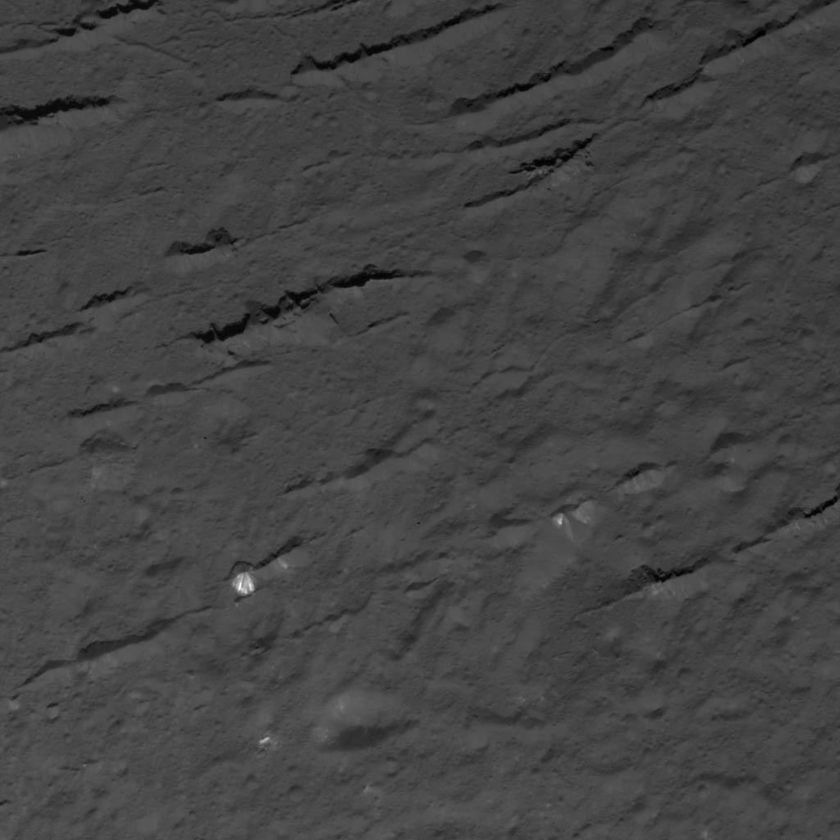
NASA / JPL-Caltech / UCLA / MPS / DLR / IDA
Floor of Occator Crater
Dawn observed this area southwest of Cerealia Facula, near the center of Occator Crater, on July 4 from an altitude of 30 miles (48 kilometers). The view here is 3.0 miles (4.8 kilometers) across. Sunlight comes from the top of the picture, so the many straight features that are light on the bottom and dark on the top are fractures in the ground. Similarly, craters are light on the bottom, where the crater wall catches the light, and dark on the top, where the wall is in shade. Elevated features, like mounds, in this strange terrain are light on the top and dark on the bottom. Several pictures in the
Aug. 22 Dawn Journalshow similar fractured scenery.
Full image and caption.
On Oct. 31, Dawn flew down to peridemeter (the low point of its elliptical orbit) shortly after 5:00 am PDT. As always, to keep its solar arrays pointed at the Sun and its sensors pointed at the ground, it had to fire its hydrazine thrusters extensively. Using the thrusters was routine after having operated for more than half of its time in space without the use of the reaction wheels that were intended for controlling its orientation, but which had failed. While the spacecraft didn't know the hydrazine was about to run out, mission controllers had known for quite some time.
As is typical for missions in deep space, Dawn operated most of the time out of radio contact. NASA's Deep Space Network (DSN) cannot serve all missions simultaneously, and often spacecraft have tasks to perform that are incompatible with radio communications. As it turned out, however, Dawn's final moments happened to be while the largest antenna at the Goldstone Deep Space Communications Complex in California was tracking it. The 230-foot (70-meter) antenna thus allowed the flight team to hear Dawn's swan song.
We have described before that with Dawn broadcasting through an auxiliary antenna when it flew close to the ground, scientists and engineers could learn about Ceres' interior. The spacecraft's radio signal was too weak to carry data to the DSN. Rather, it was as if Dawn were playing a single note with no variation. That may not make for an especially imaginative or melodious performance, but as different regions underground exerted their gravitational pulls and accelerated and decelerated the probe, the Doppler shift was music to the ears of planetary geologists.
By observing changes in the strength and some other characteristics of the signal (and knowing the likely explanation), engineers were able to reconstruct some of the spacecraft's final actions. Around 20 minutes after it was at peridemeter, still quite low but with its momentum starting to carry it back up to high altitudes, the hydrazine thrusters became ineffective. Dawn recognized that it could no longer control its orientation (although it did not know the reason) and systematically proceeded through all the contingency procedures possible, such as swapping to backup equipment and even rebooting its main computer. It made valiant attempts and continued to operate with the professionalism of a dedicated, veteran space explorer, but without hydrazine, there was nothing it could do. The outcome was inevitable. Dawn was up against an unsolvable problem.
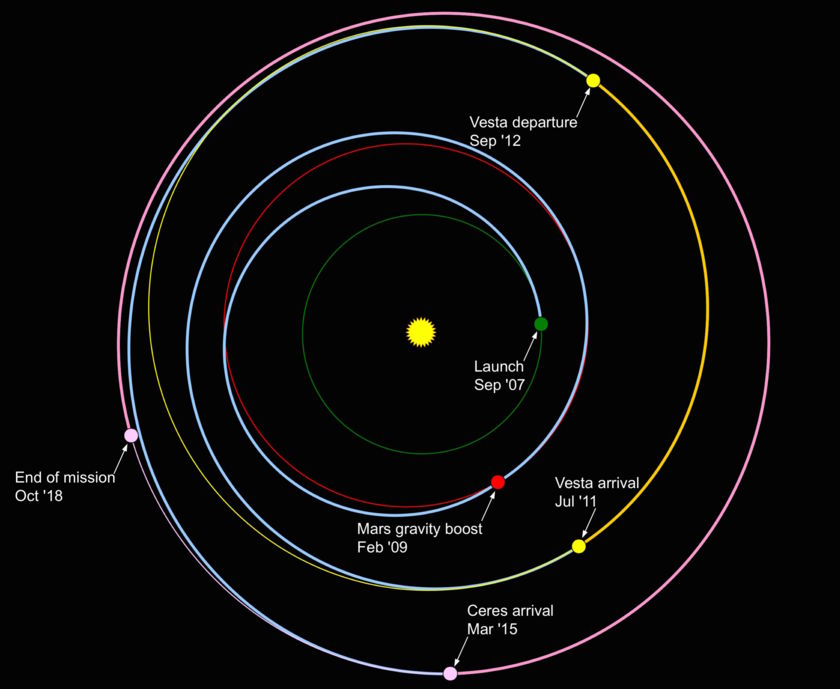
NASA / JPL-Caltech
Dawn mission trajectory
Dawn's interplanetary trajectory (in blue). Over the course of the mission, we have charted the spaceship's progress on this figure, most recently in
September. There will be little need to update it again.
Although the spacecraft's depletion of hydrazine and subsequent inability to communicate had been predicted for quite some time, your correspondent considered it worthwhile to verify the diagnosis. It was possible, albeit highly unlikely, that some other problem had befallen Dawn and that after the scheduled session with the Goldstone antenna, the sophisticated robot would solve it and try to reestablish radio contact.
The plan then was for the flight team to look for Dawn at night. Hours after young trick-or-treaters everywhere had finished extorting sweets from their elders, when Earth had rotated so that another 230-foot (70-meter) antenna, the largest at the Madrid Deep Space Communications Complex, could point at Dawn's location in the sky, controllers listened again. Not even the faintest whisper was heard. The remote spacecraft was orbiting Ceres as silently as the cold vacuum of space itself.
After more than 11 years of an incredibly exciting, fantastically fruitful, extremely difficult, deeply rewarding, super fun and just totally awesome interplanetary adventure, your correspondent declared the mission over shortly before 1:30 am PDT on Nov. 1.
The mission had been a dream come true. Now the dream was over.
Somehow, the stark reality of the end of the phantasmagorical mission in the middle of the night seemed to turn upside down the meaning of a proverb commonly (but vaguely) attributed to Africa: "However long the night, dawn will break."
This video captures some of the highlights of Dawn's interplanetary adventure, as well as some personal reflections on it.
With a rare excursion into first person, I wrote in my Aug. 22 Dawn Journal about how I felt with the mission coming to an end (and offered a fanciful additional perspective at the end of my Sept. 27 Dawn Journal). My feelings were unchanged when the end came. Nevertheless, in the actual event, I wrote down some of my thoughts, because Dawn was such a significant part of my life, and I am well aware of the fallibility of human memory. Memories, however vivid, are often more of a reconstruction than people like to believe.
But I quickly realized that it didn't matter how I was feeling! Here is an unedited excerpt of what I wrote after declaring the mission to be over: "These feelings are transitory, and I don't need to remember them anyway. It would be a mistake to consider how I feel now as somehow representing my overall experience or feelings about the mission. Indeed, this is very much the wrong time to try to put it into perspective. It would make a good story if I had some revelation or profound description of my feelings at this point, but there's no reason I should. It takes time to gain a good perspective. People construct and then gradually change their memories, all without any awareness. And I should not think that somehow now I will be imbued with the wisdom, insight, or other capability to put this into perspective. If I feel sad, elated, disappointed, relieved, proud, empty, gratified or any of myriad other feelings -- and, more to the point, a combination of myriad feelings -- I won't feel that way again. The end of Dawn is not what's important. All that preceded it is. And I cannot so easily grasp it all right now, so my feelings now are not as special or as meaningful as one might be tempted to think."
Finally, you can't appreciate the end of the mission if you don't appreciate the rest of the mission. So, feel free to reread the previous 310,000 words in Dawn Journals to gain the full appreciation.
There will be future opportunities to address some of the overall accomplishments of the mission and discoveries about Ceres. For now, we will devote more attention to this final phase.
And there was no doubt about its finality. On Nov. 1-2, immediately after the official end of the mission, there was not enough time to reallocate previously scheduled DSN antenna time to other missions. So although confidence was high that Dawn would forever be silent, each of the three deep space communications complexes (Goldstone, then Canberra, and then Madrid) turned a sensitive ear to Ceres for one last time. No surprises occurred.
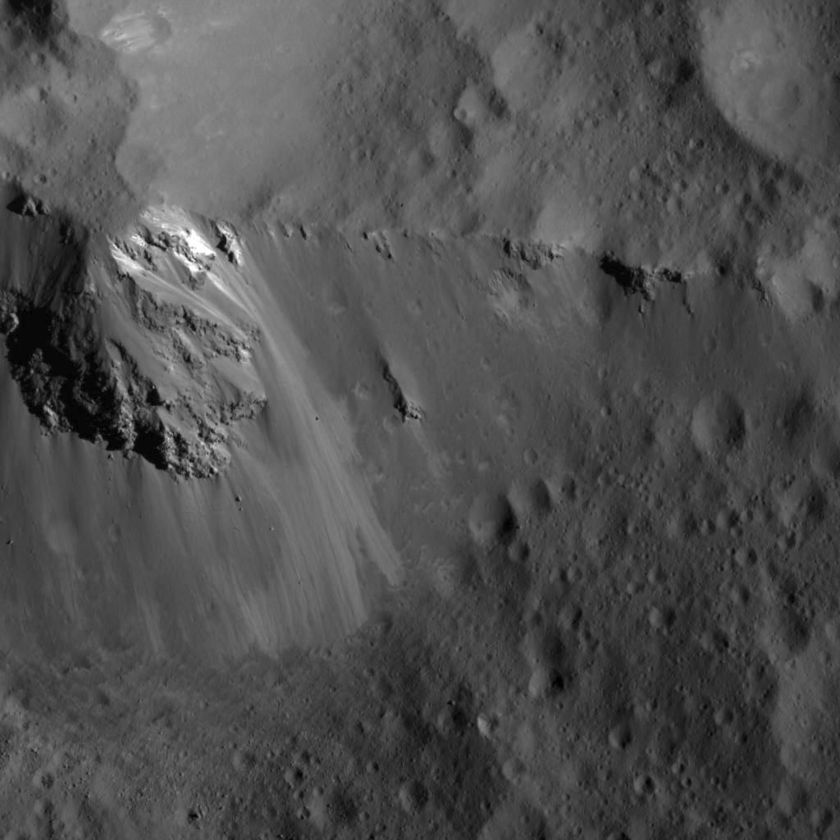
NASA / JPL-Caltech / UCLA / MPS / DLR / IDA
Ridge within Urvara Crater
Dawn took this picture of a ridge in the center of Urvara Crater on July 16 from an altitude of 32 miles (58 kilometers). The scene is 3.4 miles (5.5 kilometers) wide. Note the patterns of flow down the slope. We saw this landscape from twice as high (and therefore with only half as much detail) in
August. The
location of peridemeter shifted in XMO7, so during the 10 days between the earlier picture and this one, Dawn's altitude when it flew over this location decreased, allowing it to capture this sharper view.
Full image and caption.
The final phase of Dawn's exploration began in June when it completed maneuvering to XMO7. We have explained that as the orbit precessed so that peridemeter gradually shifted from Ceres' day side to the night side, photography, infrared spectroscopy and visible spectroscopy became less valuable. The spacecraft had collected a tremendous number of such measurements earlier in the mission, so when it flew over illuminated terrain in XMO7 at higher altitudes than it had already been, new observations were not worthwhile. (Low altitude measurements of Ceres' nuclear radiation and gravity continued in darkness to the very end of the mission.)
Recognizing that the hydrazine would be long gone by the time peridemeter moved back to the day side, controllers took advantage of a nice opportunity at higher altitude for a last, fond look at Ceres on Sept. 1-2. As the dwarf planet pirouetted before the admiring eye of its permanent companion, Dawn recorded its final views of Ceres. One of them is shown above and another is below.
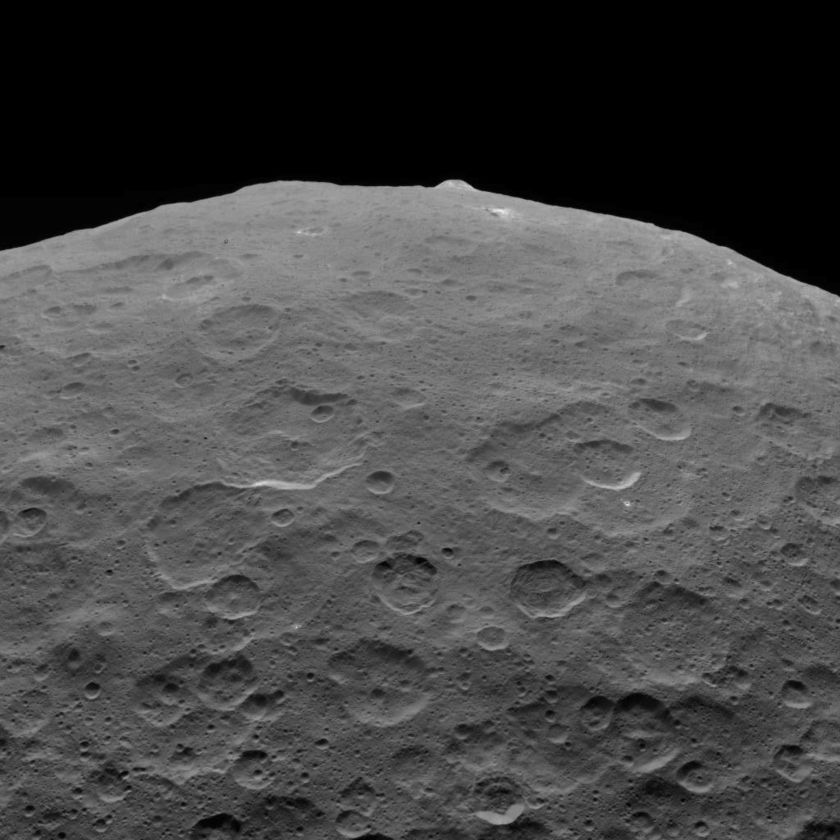
NASA / JPL-Caltech / UCLA / MPS / DLR / IDA
Limb of Ceres
On Sept. 1 while coasting up, Dawn looked back at Ceres from an altitude of 2,220 miles (3,570 kilometers). Prominent on the limb, at a distance of 2,500 miles (4,030 kilometers), is Ceres' youngest cryovolcano, Ahuna Mons. Scientists have identified more than 20 other likely Cerean cryovolcanoes, but they are generally less distinct, because, like some of the craters, the dwarf planet slowly
erasesthem. We have seen many other views of Ahuna Mons, most recently
here. We saw the mountain on the limb (with Occator Crater in the view as well) from even higher up
last year.
Full image and caption.
On Sept. 28 and 29, Dawn performed a calibration of the camera and the visible and infrared mapping spectrometer for one last time. They are precision scientific instruments, and the thorough analysis of their data depends on accurate knowledge of their sensitivity and other properties. The team has conducted calibrations throughout the mission so even slight changes could be detected and accounted for in interpreting the pictures and spectra and drawing conclusions about the nature of Vesta and Ceres. Dawn expended a little more of its remaining hydrazine to point the instruments at the stars Vega and Arcturus, which they had observed before. Indeed, the first time was less than three months after the journey began in 2007 (and Vega still holds special significance).
Even though Dawn took no more pictures nor infrared or visible spectra of Ceres after the beginning of September, it acquired a great many before that, far exceeding the team's expectations when planning this phase of the mission. In XMO7, the spacecraft sent more than 11,000 photographs of Ceres to Earth, almost all of them at very low altitude, revealing amazing new details. (This brought the total for Vesta plus Ceres to more than 100,000 pictures.) Also during XMO7, Dawn provided scientists with more than three million infrared spectra and almost 50,000 visible spectra.
We have explained before that Ceres' nuclear glow is very faint, so the gamma ray and neutron detector (GRaND) requires a great deal of data to make its measurements, just as a camera needs a long exposure to record a dark scene. Despite its name, GRaND is meek and unprepossessing, but the instrument does do a wonderful job revealing the atomic composition of the material down to about a yard (meter) underground. GRaND does not need illumination, so it continued to operate even as Dawn glided over ground cloaked in the deep dark of night.
In XMO7, GRaND acquired 140 hours of nuclear spectra from altitudes below Dawn's previous low altitude orbit, at 240 miles (385 kilometers) in 2015-2016. And it accumulated 50 hours of measurements of Ceres' radiation from within 60 miles (100 kilometers) of the ground. GRaND collected about four times as much data in XMO7 as scientists needed to meet their objectives. This will allow them to see Ceres' elemental abundances with much sharper resolution, like a close-up picture, than ever before.
Like the other investigations, gravity measurements far surpassed what the team expected not only when planning XMO7 but even when the spacecraft was there.
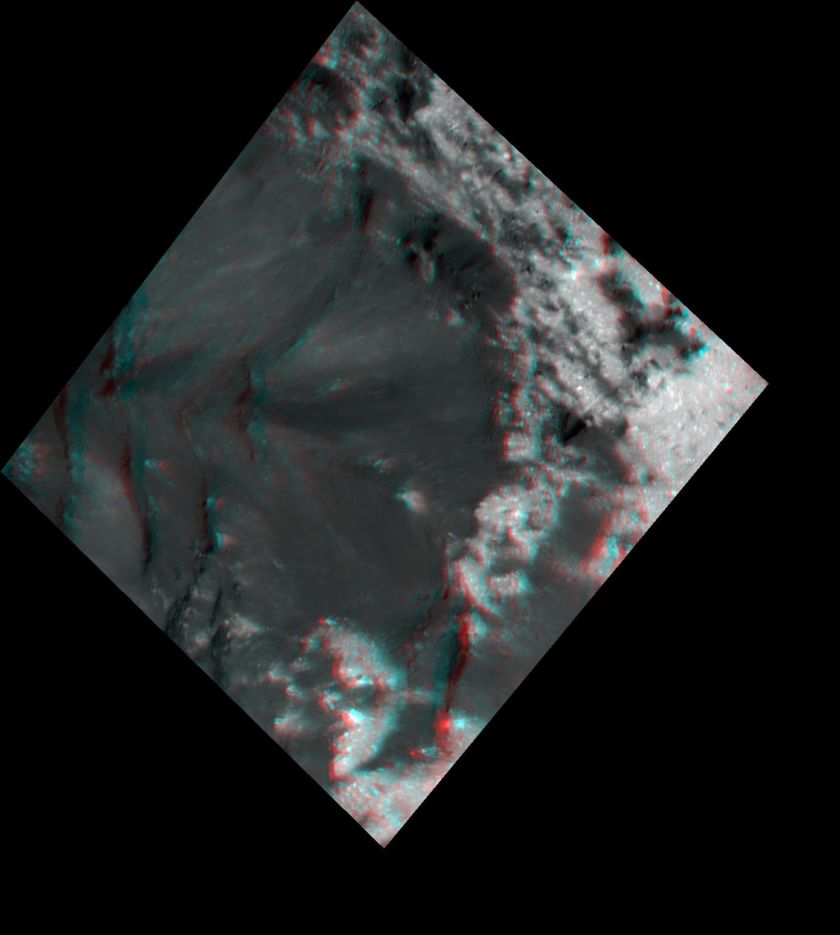
NASA / JPL-Caltech / UCLA / MPS / DLR / IDA / USRA-Lunar and Planetary Institute
3D view of terrain on Ceres
This 3-D image of an area northeast of Cerealia Facula was constructed with two photos Dawn took from an altitude of 21 miles (34 kilometers) in June. The spacecraft peered down at this exotic landscape from different angles in two orbital passes, providing the pair of stereo pictures. To perceive the 3-D, you need color filters, with red for your left eye and blue for your right. (You could get a 4-D view by looking at it for a while. However, apart from the daily and annual changes in the angle of the incoming sunlight, no changes are expected to be discernible even over a few years. Patience, and a follow-up mission, would be required.)
Full image and caption.
With the smooth and productive operations in XMO7, these successes may all seem pretty simple. After all, it's only the cutting edge of rocket science, operating an ion propelled spaceship at incredibly low altitude around a dwarf planet well over a million times farther away than the International Space Station. But there were a few challenges to overcome. The team confronted and solved myriad problems to accomplish so much.
Now, even if you don't have your own interplanetary spacecraft, you can explore Ceres and do so from the comfort of your home. Instead of going all the way to the main asteroid belt, bring that distant world to your computer with Cerestrek. You can also see all the sights on the first world Dawn unveiled with Vestatrek.
Dawn, however, will never again explore alien worlds. It will never again emit a bluish beam of xenon ions. It will never again communicate with beings on the faraway planet where its voyage began. It will never again perform any of the functions or tasks it executed so admirably on its remarkable journey. For decades, and quite possibly even for centuries, the ship that undertook a long, daring, difficult and successful deep-space expedition on behalf of humankind will remain silently in orbit around Ceres. It has become an inert celestial monument to the power of human ingenuity, creativity, and curiosity, a lasting reminder that our passion for bold adventures and our noble aspirations to know the cosmos can take us very, very far beyond the confines of our humble home.
Dawn is 1,800 miles (2,900 kilometers) from Ceres. It is also 3.53 AU (328 million miles, or 527 million kilometers) from Earth, or 1,320 times as far as the moon and 3.56 times as far as the Sun today. Radio signals, traveling at the universal limit of the speed of light, will never again make the round trip.
Dr. Marc D. Rayman
7:30 am PST November 11, 2018
from Planetary Society Blog http://bit.ly/2A9w0uE
via IFTTT
沒有留言:
張貼留言